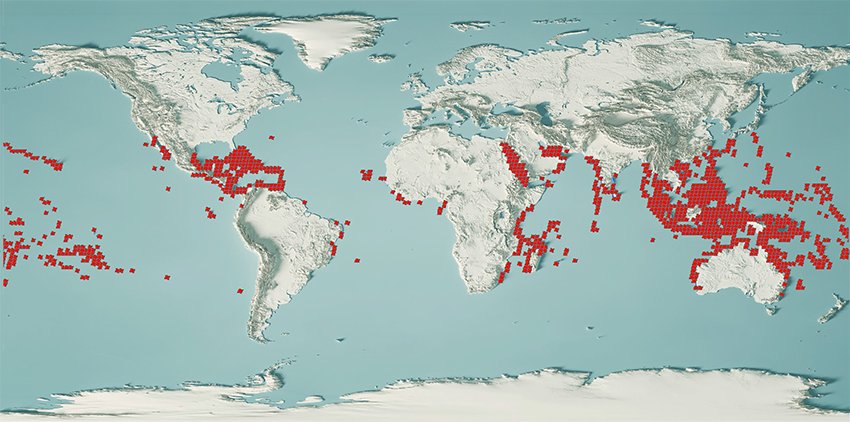
Coral Reefs: The World Beneath the Waves
Coral reefs significantly impact our lives on land, but some research suggests these underwater ecosystems are disappearing. How should Christians respond?
Picture the most beautiful place on earth. Maybe you envisioned a beach of pristine sand and white-capped waves. Or maybe you saw yourself on a boat with nothing but turquoise water stretching in all directions. While the beach and ocean are indescribably alluring, some of the most incredible sights lie beneath the water’s surface.
In the tropical ocean waters fringing many of the continents lie vast stretches of colorful structures resembling underwater gardens. These vivid structures are not constructed of plants but living animals. We know them best as coral reefs and can find them in shallow and deep water all around the world. The most well-known reef, the Great Barrier Reef off the coast of Queensland, Australia, covers over 130,000 square miles. This reef system is visible from space. In 2020, oceanographers found a reef in Australian waters that was 1,640 feet tall—taller than the Eiffel Tower in Paris.
Coral reefs occupy less than 1% of the entire ocean floor, yet are home to 25% of all marine species.
Even more impressive than the area that reefs occupy is the variety of life that calls them home. We use the term biodiversity to provide a measure of the diversity of lifeforms living in an ecosystem. More species typically means higher biodiversity. Coral reefs are the most biodiverse ecosystems on earth. Not even tropical rainforests can compete with the variety of life in coral reefs. Coral reefs occupy less than 1% of the entire ocean floor, yet are home to 25% of all marine species. Over 4,000 species of fish—including some of the most visually vibrant such as clown fish, tangs, parrotfish, seahorses, and butterfly fish—live in coral reefs. Around 3,000 species of other animals have been documented to spend all or most of their lives in reefs, including some sea turtles, moray eels, and marine mammals.
With such a diversity of life dwelling in coral reefs, it’s no surprise that humans rely heavily on these ecosystems for resources. Nearly 500 million people derive1 a significant portion of their food and/or revenue from reefs, mostly through the fishing industry and tourism. In the tourism industry, the world’s coral reefs are worth billions of US dollars per year.2

Coral reefs also provide coastal protection, absorbing wave action that would erode the coastline of areas that tens of millions of people call home.3 Additionally, corals are a source of medicine used to treat diseases such as cancer, arthritis, and Alzheimer’s.
But often in the news, we read reports claiming that climate change is heating the world’s oceans, threatening the survival of coral reefs. Some scientists even predict that coral reefs might disappear entirely in the coming decades. Political philosophy related to the climate change issue must be carefully dissected from actual evidence related to climate change concerns. However, God made us stewards of the world, even the world beneath the waves. Given the extent to which humans and animals rely on corals, we should educate ourselves on these essential ecosystems and the actual threats to their survival so we can exercise discernment and steward coral reefs well.
What Are Corals?
Many animals, and even algae, contribute to the construction of these biological reefs, but no animals play a bigger role than corals. While corals come in many shapes, sizes, and types, stony corals (scleractinians) are the primary organisms responsible for building coral reefs. The individual corals, called polyps, often live in colonies comprised of thousands of organisms. The coral colonies grow in size as the polyps pull calcium from the sea water and use it to build an exoskeleton to recede into. Periodically, the polyps will separate from their skeletons and build another layer on top of the previous one. When a coral polyp dies, its skeleton remains as a scaffold on which other corals can build. Over time, these coral colonies grow into enormous reefs.
Corals display one of the best examples of mutualism found anywhere on earth. Mutualism is a symbiotic relationship between two or more species where all organisms benefit from their interactions. Corals are mutualistic with single-celled photosynthetic algae known as zooxanthellae (pronounced zoe-uh-zan-THEH-luh). These tiny creatures live inside coral tissues and pay their rent by making sugars from sunlight and carbon dioxide, giving the coral a nearly limitless supply of food. The zooxanthellae benefit from the protection the coral provide and the materials the coral pull out of sea water. Mutualistic relationships require a very careful, well-designed balance of give and take, but when disturbed, they can break down.
In response to high temperatures, corals become stressed and evict their zooxanthellae tenants who produce toxins in response to this thermal stress. If the heat wave is short, this breakdown can be reversed. However, if the heat persists for an extended period, the corals will die from lack of nutrients. Because the color of coral comes from their tiny partners, these dead corals look bleached (inspiring the term coral bleaching).
Over the past few decades, the world has experienced more prolonged periods of heat compared to historical records dating back to the late 1800s, leading to the extensive loss in corals and the reefs they build. Most scientists accept the idea that this rise in heat is attributable to climate change caused by human activity. But according to the fossil record, corals have played this disappearing game before.
Corals Worldwide
Coral reefs cover around 110,000 square miles (284,300 km) around the world. Of course, you might be familiar with the Great Barrier Reef in Australia, but coral reefs show up scattered throughout the Caribbean (including the Florida Keys), off the coast of Central America, along the east coast of Africa, and even in the Red Sea.
Indonesia has the most area with coral reefs at nearly 18%. Roughly 80 countries host coral reefs in their waters. Many reefs grow in an area called the “coral triangle” among the Indonesian and Philippine Islands.
Some corals grow in deep, cold water, such as along South America, because they do not need zooxanthellae (algae) to survive.

Coral Comeback
From the fossil record, we infer an interesting story regarding coral reefs. The Great Barrier Reef was one of the first modern reef systems to develop. After studying the coral thickness, some creation scientists believe this reef appeared just 3,700 years ago.4 This reef and other modern reefs are restricted to a small portion of the earth’s sea floor. But the distribution of reefs has been far more extensive during other periods of earth history, with large deposits of fossil reefs in Australia and all over the Northern Hemisphere, including the United Kingdom and the Great Lakes region of North America. In fact, hundreds of thousands of visitors to Michigan take home a piece of these fossilized reefs as a souvenir each year in the form of Petoskey stones. Petoskey stones are pebble-shaped, fossilized coral that have been worn smooth over time.
Many species of coral appear all at once in the fossil record, disappear all at once, and reappear in later deposits. Six entire families of coral disappear from the fossil record during the global flood of Noah’s day.5 Corals reappear in post-flood deposits a couple hundred years after the flood, only to completely disappear from the fossil record. It seems that corals have a history of becoming common enough to leave fossils and then becoming too rare to leave a record.6 Modern coral reefs may be repeating this cycle.
In no other period of history has the climate varied so extremely than the time of the flood and the following ice age. During the flood, Scripture says the “fountains of the deep” broke open, releasing hot water from inside the earth and causing violent volcanic activity. For the first few centuries after the flood ended, this gradually waning volcanic activity would have continued to keep the oceans warm and fill the atmosphere with particles of ash. These particles would have deflected sunlight, causing cooler temperatures. Additionally, the heated waters would have caused higher levels of evaporation, resulting in heavy rainfall in equatorial regions and heavy snowfall in higher latitudes. Rapid climate fluctuation during the volatile post-flood period may have caused coral to disappear from the fossil record and reappear later.
Presently, coral reefs seem to be staying true to this cycle as they become less common around the globe. Some reefs have lost over 50% of their reef area. While new reefs are forming in some areas and some reefs have experienced far less loss than others, the total area of sea floor covered with coral seems to have decreased by nearly 50% in the last five decades. Some forecasts predict 90% of all coral reef areas will be gone by 2050.
We recognize that the climate fluctuates in a normal pattern of variability. Regardless of the extent to which human activities might be contributing to climate change, corals seem to be responding to current rising temperatures by fading away. But as to whether they will disappear completely, only time will tell. We do not know that the earth’s temperature will continue rising, but we do know that God is in control of his creation.
Since corals made a comeback following their most recent disappearance during and after the global flood, some individual corals must have survived the last disappearance, giving us hope for corals struggling to survive today.

TOP ROW: striped sweetlips, green sea turtle, spotjaw blenny fish; MIDDLE ROW: Mediterranean seahorse, pharaoh cuttlefish, coral grouper; BOTTOM ROW: clown fish, Mediterranean red sea star, lionfish
Taking Care of Themselves
Corals are not at the mercy of rising temperatures without any mechanisms for defense. God created corals and all animals with the genetic variation to change in response to stress in a dynamic post-fall world. Like all organisms, corals have some individuals that are more tolerant to rising ocean temperatures than others. As the stress becomes more intense, the less resilient coral individuals bleach, leaving the stronger individuals to reproduce and pass on their resiliency. Eliminating the weaker individuals can actually make the entire population more tolerant to high temperatures.
In addition to variation of individuals within a species, some species of coral are more comfortable than others at handling the increased temperatures. The principal fear of some scientists, however, is that ocean waters might heat more quickly than what any coral individual or species can handle without human intervention. This fear does not seem to be justified by the data, as corals survived a rapid heating period soon after the flood7 and some coral species are extremely heat tolerant.
Stewarding Coral Reefs
Scripture states in Genesis 1 that God created humans in his image and placed us in a position to steward his creation. We have the unique responsibility to care for the present and future needs of the earth and all mankind, while also ensuring that we never put the cares of animals above the cares of man. But to ensure the welfare of the people and creatures that depend upon this underwater ecosystem, maintaining coral reefs will require some creativity and healthy management.
Scientists have tried to use artificial selection to accelerate the rate at which coral populations adjust to increased ocean temperatures. By applying heavy pressure on corals in the laboratory, they can eliminate the least tolerant individuals and produce more hearty corals. Introducing more resilient individuals into areas where reefs have experienced significant bleaching can repair and regrow reef systems.
Scientists are also trying to mitigate reef loss by monitoring the species that prey on corals. The quantity of these predators, including the crown-of-thorns sea stars, has exploded in recent years. Because these organisms feed extensively on coral, Australia and other countries have developed programs for reducing their numbers in delicate reefs.
Finding solutions to conserving coral reefs allows us to exercise our God-given creativity to help these animals adapt to a changing world.
Getting Close to Corals
Good stewardship starts by understanding and appreciating God’s creation. Consider planning a vacation in an area close to a coral reef. With some snorkeling gear, you can catch a glimpse of these underwater wonders. Study the animals that make and live in the reefs and talk to people directly impacted by coral reefs.8
The world of coral reefs beneath the waves deeply impacts our world here on land. God created these intricate ecosystems to provide a home for many kinds of life and to provide resources, enjoyment, and protection for mankind. May we manage these reefs well so that their biodiversity will continue to inspire awe and point to the Creator who filled the earth with life.
Answers Magazine
July–September 2021
Footnotes
- This data is provided by the Office for Coastal Management by the National Oceanic and Atmospheric Administration (NOAA).
- NOAA estimates that global coral reefs are worth $375 billion each year, with US reefs in the Florida Keys worth nearly $8.5 billion annually.
- NOAA estimates that coral reefs save $94 million each year in coastal erosion mitigation.
- Peter Read and Andrew Snelling, “How Old Is Australia’s Great Barrier Reef?,” Creation 8, no. 1 (1985).
- This interpretation of the fossil record assumes that the highest layer in which we find dinosaurs marks the flood and that layers above were laid post-flood.
- The Global Reef Project has traced the presence of coral reefs in the geologic layers. Adjusting the evolutionary timescale, we can correlate these layers to their deposition before and after the flood. See http://globalreefproject.com/coral-reef-history.php.
- This is known as the Eocene-Paleocene Thermal Maximum, where global temperature increased as much as 8ºC (14.4ºF) in a very short period of time (maybe as little as a decade).
- Be sure not to touch or remove any part of a coral reef. Careless tourism is a leading threat to reefs and engaging with the wildlife can be harmful and is often illegal.
Recommended Resources

Answers in Genesis is an apologetics ministry, dedicated to helping Christians defend their faith and proclaim the good news of Jesus Christ.
- Customer Service 800.778.3390
- © 2024 Answers in Genesis





